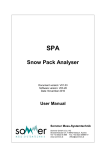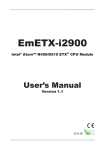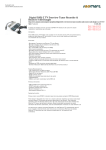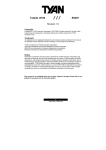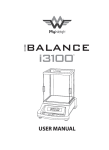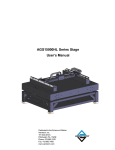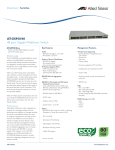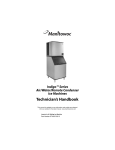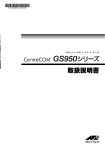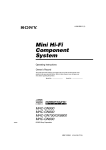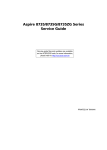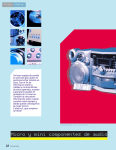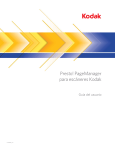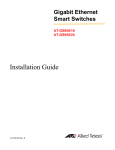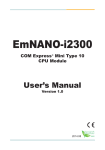Download Minimum Data Set 3.0 Resident Assessment Instrument User`s Manual
Transcript
CMS’s RAI Version 3.0 Manual CH 3: MDS Items [I] SECTION I: ACTIVE DIAGNOSES Intent: The items in this section are intended to code diseases that have a direct relationship to the resident’s current functional status, cognitive status, mood or behavior status, medical treatments, nursing monitoring, or risk of death. One of the important functions of the MDS assessment is to generate an updated, accurate picture of the resident’s current health status. I: Active Diagnoses in the Last 7 Days April 2012 Page I-1 CMS’s RAI Version 3.0 Manual CH 3: MDS Items [I] I: Active Diagnoses in the Last 7 Days (cont.) April 2012 Page I-2 CMS’s RAI Version 3.0 Manual CH 3: MDS Items [I] I: Active Diagnoses in the Last 7 Days (cont.) Item Rationale Health-Related Quality of Life • Disease processes can have a significant adverse affect on an individual’s health status and quality of life. Planning for Care • This section identifies active diseases and infections that drive the current plan of care. Steps for Assessment There are two look-back periods for this section: • Diagnosis identification (Step 1) is a 60-day look-back period. • Diagnosis status: Active or Inactive (Step 2) is a 7-day look-back period (except for Item I2300 UTI, which does not use the active 7-day look-back period). 1. Identify diagnoses: The disease conditions in this section require a physician-documented diagnosis (or by a nurse practitioner, physician assistant, or clinical nurse specialist if allowable under state licensure laws) in the last 60 days. DEFINITIONS ACTIVE DIAGNOSES Physician-documented diagnoses in the last 60 days that have a direct relationship to the resident’s current functional status, cognitive status, mood or behavior, medical treatments, nursing monitoring, or risk of death during the 7-day look-back period. FUNCTIONAL LIMITATIONS Loss of range of motion, contractures, muscle weakness, fatigue, decreased ability to perform, ADLs, paresis, or paralysis. NURSING MONITORING Nursing Monitoring includes clinical monitoring by a licensed nurse (e.g., serial blood pressure evaluations, medication management, etc.). Medical record sources for physician diagnoses include progress notes, the most recent history and physical, transfer documents, discharge summaries, diagnosis/ problem list, and other resources as available. If a diagnosis/problem list is used, only diagnoses confirmed by the physician should be entered. • Although open communication regarding diagnostic information between the physician and other members of the interdisciplinary team is important, it is also essential that diagnoses communicated verbally be documented in the medical record by the physician to ensure follow-up. • Diagnostic information, including past history obtained from family members and close contacts, must also be documented in the medical record by the physician to ensure validity and follow-up. 2. Determine whether diagnoses are active: Once a diagnosis is identified, it must be determined if the diagnosis is active. Active diagnoses are diagnoses that have a direct relationship to the resident’s current functional, cognitive, or mood or behavior status, medical treatments, nursing monitoring, or risk of death during the 7-day look-back period. Do not include conditions that have been resolved, do not affect the resident’s current status, or do not drive the resident’s plan of care during the 7-day look-back period, as these would be considered inactive diagnoses. May 2013 Page I-3 CMS’s RAI Version 3.0 Manual CH 3: MDS Items [I] I: Active Diagnoses in the Last 7 Days (cont.) • Item I2300 UTI, has specific coding criteria and does not use the active 7-day look-back. Please refer to Page I-8 for specific coding instructions for Item I2300 UTI. • Check the following information sources in the medical record for the last 7 days to identify “active” diagnoses: transfer documents, physician progress notes, recent history and physical, recent discharge summaries, nursing assessments, nursing care plans, medication sheets, doctor’s orders, consults and official diagnostic reports, and other sources as available. Coding Instructions Code diseases that have a documented diagnosis in the last 60 days and have a direct relationship to the resident’s current functional status, cognitive status, mood or behavior status, medical treatments, nursing monitoring, or risk of death during the 7-day look-back period (except Item I2300 UTI, which does not use the active diagnosis 7-day look-back. Please refer to Item I2300 UTI, Page I-8 for specific coding instructions). • Document active diagnoses on the MDS as follows: — Diagnoses are listed by major disease category: Cancer; Heart/Circulation; Gastrointestinal; Genitourinary; Infections; Metabolic; Musculoskeletal; Neurological; Nutritional; Psychiatric/Mood Disorder; Pulmonary; and Vision. — Examples of diseases are included for some disease categories. Diseases to be coded in these categories are not meant to be limited to only those listed in the examples. For example, I0200, Anemia, includes anemia of any etiology, including those listed (e.g., aplastic, iron deficiency, pernicious, sickle cell). • Check off each active disease. Check all that apply. • If a disease or condition is not specifically listed, enter the diagnosis and ICD code in item I8000, Additional active diagnosis. • Computer specifications are written such that the ICD code should be automatically justified. The important element is to ensure that the ICD code’s decimal point is in its own box and should be right justified (aligned with the right margin so that any unused boxes and on the left.) • If a diagnosis is a V-code, another diagnosis for the related primary medical condition should be checked in items I0100-I7900 or entered in I8000. Cancer • I0100, cancer (with or without metastasis) Heart/Circulation • I0200, anemia (e.g., aplastic, iron deficiency, pernicious, sickle cell) • I0300, atrial fibrillation or other dysrhythmias (e.g., bradycardias, tachycardias) • I0400, coronary artery disease (CAD) (e.g., angina, myocardial infarction, atherosclerotic heart disease [ASHD]) May 2013 Page I-4 CMS’s RAI Version 3.0 Manual CH 3: MDS Items [I] I: Active Diagnoses in the Last 7 Days (cont.) • I0500, deep venous thrombosis (DVT), pulmonary embolus (PE), or pulmonary thrombo-embolism (PTE) • I0600, heart failure (e.g., congestive heart failure [CHF], pulmonary edema) • I0700, hypertension • I0800, orthostatic hypotension • I0900, peripheral vascular disease or peripheral arterial disease Gastrointestinal • I1100, cirrhosis • I1200, gastroesophageal reflux disease (GERD) or ulcer (e.g., esophageal, gastric, and peptic ulcers) • I1300, ulcerative colitis or Crohn’s disease or inflammatory bowel disease Genitourinary • I1400, benign prostatic hyperplasia (BPH) • I1500, renal insufficiency, renal failure, or end-stage renal disease (ESRD) • I1550, neurogenic bladder • I1650, obstructive uropathy Infections • I1700, multidrug resistant organism (MDRO) • I2000, pneumonia • I2100, septicemia • I2200, tuberculosis • I2300, urinary tract infection (UTI) (last 30 days) • I2400, viral hepatitis (e.g., hepatitis A, B, C, D, and E) • I2500, wound infection (other than foot) Metabolic • I2900, diabetes mellitus (DM) (e.g., diabetic retinopathy, nephropathy, neuropathy) • I3100, hyponatremia • I3200, hyperkalemia • I3300, hyperlipidemia (e.g., hypercholesterolemia) • I3400, thyroid disorder (e.g., hypothyroidism, hyperthyroidism, Hashimoto’s thyroiditis) October 2011 Page I-5 CMS’s RAI Version 3.0 Manual CH 3: MDS Items [I] I: Active Diagnoses in the Last 7 Days (cont.) Musculoskeletal • I3700, arthritis (e.g., degenerative joint disease [DJD], osteoarthritis, rheumatoid arthritis [RA]) • I3800, osteoporosis • I3900, hip fracture (any hip fracture that has a relationship to current status, treatments, monitoring (e.g., subcapital fractures and fractures of the trochanter and femoral neck) • I4000, other fracture Neurological • I4200, Alzheimer’s disease • I4300, aphasia • I4400, cerebral palsy • I4500, cerebrovascular accident (CVA), transient ischemic attack (TIA), or stroke • I4800, dementia (e.g., Lewy-Body dementia; vascular or multi-infarct dementia; mixed dementia; frontotemporal dementia, such as Pick’s disease; and dementia related to stroke, Parkinson’s disease or Creutzfeldt-Jakob diseases) • I4900, hemiplegia or hemiparesis • I5000, paraplegia • I5100, quadriplegia • I5200, multiple sclerosis (MS) • I5250, Huntington’s disease • I5300, Parkinson’s disease • I5350, Tourette’s syndrome • I5400, seizure disorder or epilepsy • I5500, traumatic brain injury (TBI) Nutritional • I5600, malnutrition (protein or calorie) or at risk for malnutrition Psychiatric/Mood Disorder • I5700, anxiety disorder • I5800, depression (other than bipolar) • I5900, manic depression (bipolar disease) • I5950, psychotic disorder (other than schizophrenia) • I6000, schizophrenia (e.g., schizoaffective and schizophreniform disorders) • I6100, post-traumatic stress disorder (PTSD) April 2012 Page I-6 CMS’s RAI Version 3.0 Manual CH 3: MDS Items [I] I: Active Diagnoses in the Last 7 Days (cont.) Pulmonary • I6200, asthma, chronic obstructive pulmonary disease (COPD), or chronic lung disease (e.g., chronic bronchitis and restrictive lung diseases, such as asbestosis) • I6300, respiratory failure Vision • I6500, cataracts, glaucoma, or macular degeneration None of Above • I7900, none of the above active diagnoses within the past 7 days Other • I8000, additional active diagnoses Coding Tips The following indicators may assist assessors in determining whether a diagnosis should be coded as active in the MDS. • There may be specific documentation in the medical record by a physician, nurse practitioner, physician assistant, or clinical nurse specialist of active diagnosis. — The physician may specifically indicate that a condition is active. Specific documentation may be found in progress notes, most recent history and physical, transfer notes, hospital discharge summary, etc. — For example, the physician documents that the resident has inadequately controlled hypertension and will modify medications. This would be sufficient documentation of active disease and would require no additional confirmation. • In the absence of specific documentation that a disease is active, the following indicators may be used to confirm active disease: — Recent onset or acute exacerbation of the disease or condition indicated by a positive study, test or procedure, hospitalization for acute symptoms and/or recent change in therapy in the last 7 days. Examples of a recent onset or acute exacerbation include the following: new diagnosis of pneumonia indicated by chest X-ray; hospitalization for fractured hip; or a blood transfusion for a hematocrit of 24. Sources may include radiological reports, hospital discharge summaries, doctor’s orders, etc. — Symptoms and abnormal signs indicating ongoing or decompensated disease in the last 7 days. For example, intermittent claudication (lower extremity pain on exertion) in conjunction with a diagnosis of peripheral vascular disease would indicate active disease. Sometimes signs and symptoms can be nonspecific and could be caused by several disease processes. Therefore, a symptom must be specifically attributed to the disease. For example, a productive cough would confirm a diagnosis of pneumonia if specifically noted as such by a physician. Sources may include radiological reports, nursing assessments and care plans, progress notes, etc. October 2011 Page I-7 CMS’s RAI Version 3.0 Manual CH 3: MDS Items [I] I: Active Diagnoses in the Last 7 Days (cont.) — Listing a disease/diagnosis (e.g., arthritis) on the resident’s medical record problem list is not sufficient for determining active or inactive status. To determine if arthritis, for example, is an “active” diagnosis, the reviewer would check progress notes (including the history and physical) during the 7-day look-back period for notation of treatment of symptoms of arthritis, doctor’s orders for medications for arthritis, and documentation of physical or other therapy for functional limitations caused by arthritis. — Ongoing therapy with medications or other interventions to manage a condition that requires monitoring for therapeutic efficacy or to monitor potentially severe side effects in the last 7 days. A medication indicates active disease if that medication is prescribed to manage an ongoing condition that requires monitoring or is prescribed to decrease active symptoms associated with a condition. This includes medications used to limit disease progression and complications. If a medication is prescribed for a condition that requires regular staff monitoring of the drug’s effect on that condition (therapeutic efficacy), then the prescription of the medication would indicate active disease. • It is expected that nurses monitor all medications for adverse effects as part of usual nursing practice. For coding purposes, this monitoring relates to management of pharmacotherapy and not to management or monitoring of the underlying disease. • Item I2300 Urinary tract infection (UTI): — The UTI has a look-back period of 30 days for active disease instead of 7 days. — Code only if all the following are met 1. Physician, nurse practitioner, physician assistant, or clinical nurse specialist or other authorized licensed staff as permitted by state law diagnosis of a UTI in last 30 days, 2. Sign or symptom attributed to UTI, which may or may not include but not be limited to: fever, urinary symptoms (e.g., peri-urethral site burning sensation, frequent urination of small amounts), pain or tenderness in flank, confusion or change in mental status, change in character of urine (e.g., pyuria), 3. “Significant laboratory findings” (The attending physician should determine the level of significant laboratory findings and whether or not a culture should be obtained), and 4. Current medication or treatment for a UTI in the last 30 days. In response to questions regarding the resident with colonized MRSA, we consulted with the Centers for Disease Control (CDC) who provided the following information: A physician often prescribes empiric antimicrobial therapy for a suspected infection after a culture is obtained, but prior to receiving the culture results. The confirmed diagnosis of UTI will depend on the culture results and other clinical assessment to determine appropriateness and continuation of antimicrobial therapy. This should not be any different, even if the resident is known to be colonized with an antibiotic resistant October 2011 Page I-8 CMS’s RAI Version 3.0 Manual CH 3: MDS Items [I] I: Active Diagnoses in the Last 7 Days (cont.) organism. An appropriate culture will help to ensure the diagnosis of infection is correct, and the appropriate antimicrobial is prescribed to treat the infection. The CDC does not recommend routine antimicrobial treatment for the purposes of attempting to eradicate colonization of MRSA or any other antimicrobial resistant organism. The CDC’s Healthcare Infection Control Practices Advisory Committee (HICPAC) has released infection prevention and control guidelines that contain recommendations that should be applied in all healthcare settings. At this site you will find information related to UTIs and many other issues related to infections in LTC. http://www.cdc.gov/ncidod/dhqp/gl_longterm_care.html Examples of Active Disease 1. A resident is prescribed hydrochlorothiazide for hypertension. The resident requires regular blood pressure monitoring to determine whether blood pressure goals are achieved by the current regimen. Physician progress note documents hypertension. Coding: Hypertension item (I0700), would be checked. Rationale: This would be considered an active diagnosis because of the need for ongoing monitoring to ensure treatment efficacy. 2. Warfarin is prescribed for a resident with atrial fibrillation to decrease the risk of embolic stroke. The resident requires monitoring for change in heart rhythm, for bleeding, and for anticoagulation. Coding: Atrial fibrillation item (I0300), would be checked. Rationale: This would be considered an active diagnosis because of the need for ongoing monitoring to ensure treatment efficacy as well as to monitor for side effects related to the medication. 3. A resident with a past history of healed peptic ulcer is prescribed a non-steroidal antiinflammatory (NSAID) medication for arthritis. The physician also prescribes a proton-pump inhibitor to decrease the risk of peptic ulcer disease (PUD) from NSAID treatment. Coding: Arthritis item (I3700), would be checked. Rationale: Arthritis would be considered an active diagnosis because of the need for medical therapy. Given that the resident has a history of a healed peptic ulcer without current symptoms, the proton-pump inhibitor prescribed is preventive and therefore PUD would not be coded as an active disease. 4. The resident had a stroke 4 months ago and continues to have left-sided weakness, visual problems, and inappropriate behavior. The resident is on aspirin and has physical therapy and occupational therapy three times a week. The physician’s note 25 days ago lists stroke. Coding: Cerebrovascular Vascular Accident (CVA), Transient Ischemic Attack (TIA), or Stroke item (I4500), would be checked. May 2013 Page I-9 CMS’s RAI Version 3.0 Manual CH 3: MDS Items [I] I: Active Diagnoses in the Last 7 Days (cont.) Rationale: The physician note within the last 30 days indicates stroke, and the resident is receiving medication and therapies to manage continued symptoms from stroke. Examples of Inactive Diagnoses (do not code) 1. The admission history states that the resident had pneumonia 2 months prior to this admission. The resident has recovered completely, with no residual effects and no continued treatment during the 7-day look back period. Coding: Pneumonia item (I2000), would not be checked. Rationale: The pneumonia diagnosis would not be considered active because of the resident’s complete recovery and the discontinuation of any treatment during the lookback period. 2. The problem list includes a diagnosis of coronary artery disease (CAD). The resident had an angioplasty 3 years ago, is not symptomatic, and is not taking any medication for CAD. Coding: CAD item (I0400), would not be checked. Rationale: The resident has had no symptoms and no treatment during the 7-day look- back period; thus, the CAD would be considered inactive. 3. Mr. J fell and fractured his hip 2 years ago. At the time of the injury, the fracture was surgically repaired. Following the surgery, the resident received several weeks of physical therapy in an attempt to restore him to his previous ambulation status, which had been independent without any devices. Although he received therapy services at that time, he now requires assistance to stand from the chair and uses a walker. He also needs help with lower body dressing because of difficulties standing and leaning over. Coding: Hip Fracture item (I3900), would not be checked. Rationale: Although the resident has mobility and self-care limitations in ambulation and ADLs due to the hip fracture, he has not received therapy services during the 7-day look-back period; thus, Hip Fracture would be considered inactive. October 2011 Page I-10











